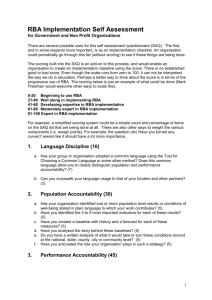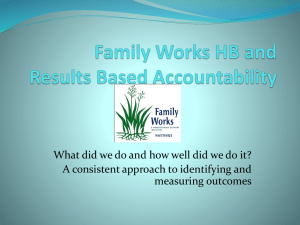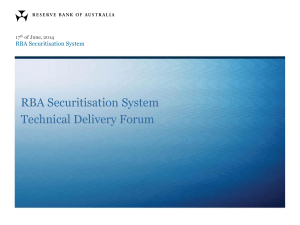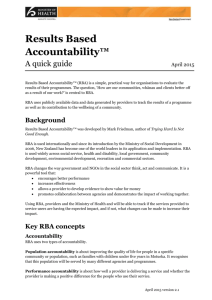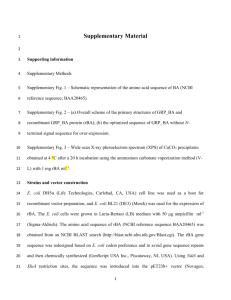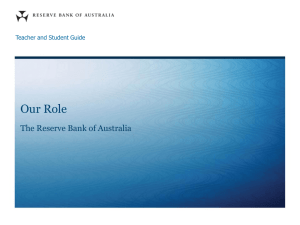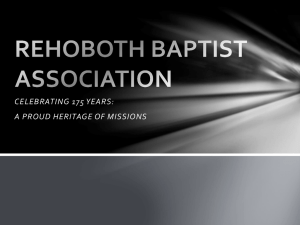2015 - Assessment Plan - Regents Bachelor of Arts
advertisement
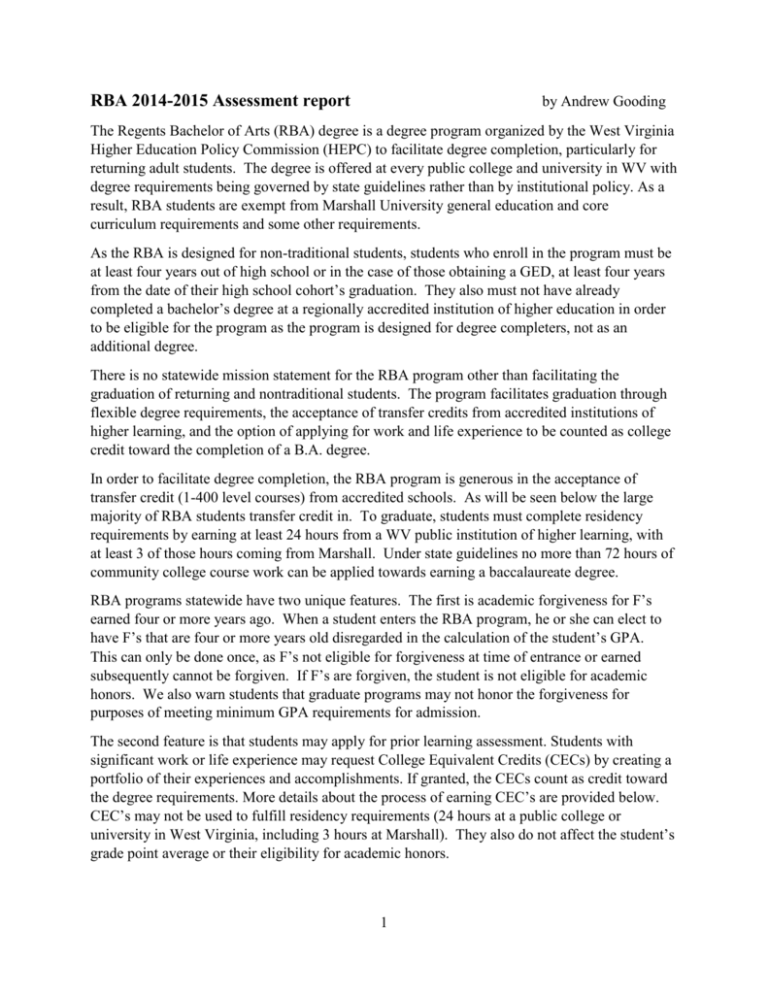
RBA 2014-2015 Assessment report by Andrew Gooding The Regents Bachelor of Arts (RBA) degree is a degree program organized by the West Virginia Higher Education Policy Commission (HEPC) to facilitate degree completion, particularly for returning adult students. The degree is offered at every public college and university in WV with degree requirements being governed by state guidelines rather than by institutional policy. As a result, RBA students are exempt from Marshall University general education and core curriculum requirements and some other requirements. As the RBA is designed for non-traditional students, students who enroll in the program must be at least four years out of high school or in the case of those obtaining a GED, at least four years from the date of their high school cohort’s graduation. They also must not have already completed a bachelor’s degree at a regionally accredited institution of higher education in order to be eligible for the program as the program is designed for degree completers, not as an additional degree. There is no statewide mission statement for the RBA program other than facilitating the graduation of returning and nontraditional students. The program facilitates graduation through flexible degree requirements, the acceptance of transfer credits from accredited institutions of higher learning, and the option of applying for work and life experience to be counted as college credit toward the completion of a B.A. degree. In order to facilitate degree completion, the RBA program is generous in the acceptance of transfer credit (1-400 level courses) from accredited schools. As will be seen below the large majority of RBA students transfer credit in. To graduate, students must complete residency requirements by earning at least 24 hours from a WV public institution of higher learning, with at least 3 of those hours coming from Marshall. Under state guidelines no more than 72 hours of community college course work can be applied towards earning a baccalaureate degree. RBA programs statewide have two unique features. The first is academic forgiveness for F’s earned four or more years ago. When a student enters the RBA program, he or she can elect to have F’s that are four or more years old disregarded in the calculation of the student’s GPA. This can only be done once, as F’s not eligible for forgiveness at time of entrance or earned subsequently cannot be forgiven. If F’s are forgiven, the student is not eligible for academic honors. We also warn students that graduate programs may not honor the forgiveness for purposes of meeting minimum GPA requirements for admission. The second feature is that students may apply for prior learning assessment. Students with significant work or life experience may request College Equivalent Credits (CECs) by creating a portfolio of their experiences and accomplishments. If granted, the CECs count as credit toward the degree requirements. More details about the process of earning CEC’s are provided below. CEC’s may not be used to fulfill residency requirements (24 hours at a public college or university in West Virginia, including 3 hours at Marshall). They also do not affect the student’s grade point average or their eligibility for academic honors. 1 Demographics of RBA Students For the 2014-14 Academic year, 301 students were taking classes in the RBA program, 163 full time and 138 part time. Due to the RBA students being older, nontraditional students, and often employed full time the number of part-time students is proportionally larger than that of most other undergraduate programs. RBA students are necessarily older than typical college students due to the requirement that they be out of high school four years before entering the program. In 2012-13 the average age of RBA students was 35 years old and in the 2014-15 graduation survey only 27 of the 65 students surveyed were in their 20’s, with 21 in their 30’s, and 17 of them being 40 or older. The flexibility of the program’s requirements and willingness to count older and transfer credits mean the program may suit older students returning to college better than traditional programs. According to the 2014-15 graduation survey 50% of RBA graduates have children and 48% worked 30 or more hours per week. 52% of those students have over $20,000 in debt and a large number have reached the limit of their financial aid eligibility. Every semester a number of students will transfer to the RBA degree as they have run out of aid in pursuing another degree. Most RBA students are not looking for their first career, but already are in one. Only 29% of RBA students plan to start their first career, while 28% plan to advance in their current career and 34% plan to change careers. After graduation 31% plan to work at the same job as they have been. RBA students often earn a bachelor’s degree to be promoted or to make a career change. Difficulties of Assessment of the RBA program The RBA program at Marshall was legislatively established in 1975 to facilitate degree completion by adult students. The program as established at the state level does not have any learning outcomes and does not offer any specific courses, so traditional direct assessment measures cannot be used to measure student progress and achievement. While other programs have milestone and capstone courses, the WV Higher Education and Policy Commission prohibits the establishment of a major or the requirement of specific courses, therefore it is impossible to directly assess their learning. The RBA students take courses like students in the rest of the university, but cannot be singled out in any particular course. Currently departments only assess the learning of students in their own major, so non-majors, such as RBA students, are not assessed through the standard departmental assessment process. If assessment of general education courses is implemented at Marshall, then that may capture more of the RBA students, though it may not account for over 1/3rd of RBA students who transfer to the RBA program the semester they graduate or the 3/4s of RBA students who transfer in hours. For the 2014-15 Academic year, of the 243 students registered on 8/14/2015 47 were starting their first semester with the RBA and had on average 95 earned hours on their transcript. 75% of RBA students had been in the program for 2 years or less. Therefore the majority of students’ earned hours take place while they are in a different program, and the RBA program serves as a graduating mechanism rather than as their home program where they spend the majority of their time learning and can be assessed from their entrance to their exit from the program. 2 Internal Transfer Students The RBA is designed for degree completion, not as a stand-alone degree program. As students must be out of high school at least 4 years, they cannot initially enroll in the RBA program on graduation from high school. While some students do enroll in the RBA program with fewer than 60 credit hours, they are encouraged to get an associate’s degree if that is possible so that they have a shorter term goal and can take advantage of the opportunities offered by that. Between Summer III 2014 and Summer II 2015, 72 students transferred and graduated in the same term. That means that for that period, when 194 students graduated, 37.1% of students were in the RBA program for less than a single semester before graduating. As traditional assessment is designed to measure gains in student learning during their time in a program, since over 1/3rd of our students do not spend even a full term in our program, then assessment of those students would not be a measure of program effectiveness. Due to the number of students transferring into and then graduating from our program in the same semester, our advisors do an equivalent of a senior evaluation on every student that enters the program and maintains paper files on every student. We update those files each semester and review them prior to graduation to keep errors to a minimum. While we use Degree Works as a spot check on students, its inability to account for repeated courses or correctly code transfer courses means that the old way of doing student records still works the best for us. External Transfer Students In addition almost 3/4’s of our students have transfer hours, with almost 2/3’s of our students having the equivalent of two or more semesters (30 or more hours) of work. Due to the difficulty some students have with getting transfer credits counted toward degree requirements, a number of transfer students end up by finishing the RBA degree due to our more flexible requirements, and the acceptance of credit from community colleges and for work experience. For Fall 2015, 218 of the 287 students (76%) registered as of 9/11/2015 had some transfer hours and 172 of those students (60%) had 30 or more transfer hours. For Spring 2015 as of the end of that term, 193 of 256 students (75%) had some transfer hours, with 159 of these students (62%) having 30 or more transfer hours. So assessment of these students is difficult as many started elsewhere or spent a significant amount of time at another school before finishing their degree. Distance Students In the past it was difficult to determine whether students were taking courses online or on campus. We knew that RBA students on the whole took at least half of their coursework online, but it was hard to tell whether a particular student was on campus or online except by looking at their individual record. Now that there is a Distance classification for students for tuition purposes, it is possible to see that 30% (85 of 287) of students registered for Fall as of 9/11/15 were classified as distance students based on their previous enrollment at Marshall. This number certainly underrepresents the total as the new classification was put in place July 1st 2015 and students have to submit a form to change their status if they had taken a class on the 3 Marshall campus in the past two years. Many students change to the RBA when they move from Huntington and they are no longer able to complete their previous choice of degree. The RBA is one of only three 4 year undergraduate degrees at Marshall that can be completed online. Previously a number of RBA students, particularly those at satellite campuses would combine online and in person courses, but the new classification and fee structure discourages that. Marshall has not really looked at distance students as a separate category of student due to the difficulty of identifying them. A separate assessment of these students would help to identify differences between in person and online instruction and might also serve to identify practices that would benefit distance student’s success. As the RBA is one of only three online undergraduate programs, having a better understanding of how students fare in online courses would help improve retention and graduation rates for those students, who have needs and opportunities qualitatively different than on campus students. Currently all students taking a particular course are assessed together by the department, whether they are taking the classes in person or online. With further assessment of students in online courses, we would have a better idea of how that format impacts student learning, persistence and success. Achievement Levels of RBA Students In an in depth study of GPA’s for RBA students versus those in the Marshall University population as a whole, Dr. David Pittenger found no discernible difference in academic achievement. RBA students go into graduate study at a relatively high rate, more numbers are needed on this as well as the student’s level of success once they enter graduate school. Dr. Pittenger, Dean of the Graduate College sees a high number of RBA students spread across a number of programs. As we don’t have the resources to survey alumni, and many of the students have very little with the program as a significant proportion transfer in the same semester they graduate, we don’t have numbers, but only anecdotes on how students fare once they enter the workforce. Graduation Rates for RBA Students Over the last 5 years, the RBA program has averaged 250 graduates per semester, with over 5,000 graduates since the program’s founding in 1975. This makes us the largest degree program on campus as measured by the number of graduates, over 2.5 times bigger than the next largest degree granting program and largest RBA program in the state. We have one full time staff member, Jerri Clagg who spends most of her time putting students on the graduation list. Satisfaction of RBA Students with the Program The most recent 2014-15 graduation survey show that over half the students finished the program in less than 8 semesters and 97% thought that their degree educated them as well as other graduates. Perceptions of others has been an issue with 57% saying that others have questioned the value of their degree. However 68% say they plan to attend graduate school to increase their credentials, as it is often possible for a student to complete the RBA and a Master’s degree in the same amount of time and sometimes less than it would take to complete another 4 year degree. 4 Our two program advisors, Jerri Clagg with 35 years of experience working in the RBA program and Rita Spears has 17 years of full time experience with the RBA program. Rita and Jerri are two of the most respected and liked advisors on campus. Students are constantly telling us how nice it is to be in a program where they get good advice and feel like they are taken seriously as students and people. Future Plans for Assessment Possible ways to do direct assessment in the future are by introducing courses specifically for RBA students. One would be a course which would prepare students for the workforce that would be oriented toward fifth and sixth year seniors who were on campus. However this would be a somewhat unrepresentative group as the majority of our students are returning to school after a period of time and many do not take their courses on campus. Still instituting this course would benefit students who are unclear about what direction to go in seeking employment or entrance to graduate school after completing their degree. We plan to implement the new course for the 2nd 8 weeks of the spring semester as a one credit/noncredit course, ITL 301 Portfolio Development is in the catalog, but we may need to add a new course description for it. Another possible course would be one that prepares students to write portfolios. Again this would be an unrepresentative sample, but if this course was instituted online, it may capture a different population of the students that the RBA program serves. This course is already in the catalog as a 3 credit graded class ITL 403 Advanced Portfolio Development. The director plans to seek certification as an online instructor through the Quality Matters program to teach this course online with the initial offering being projected for Summer Session III 2016. WVROCKS is a set of online courses that are only open to RBA students, so it might be possible to get assessment information from that program, though there would need to be a way to identify Marshall students separately from the other students. During the initial phase-in of the program Marshall students often were the ones who registered late, as courses were added late to the schedule and these sometimes were the only courses available without pre-requisites, but now as courses are available further ahead of time, the sample should be more representative. As there are over 200 Marshall student registrations this is a larger sample than the others would be. 5
